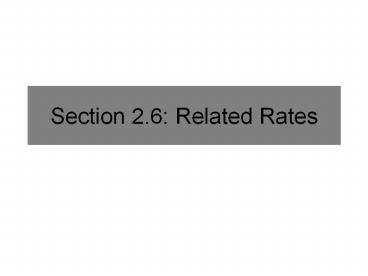Section 2.6: Related Rates PowerPoint PPT Presentation
1 / 12
Title: Section 2.6: Related Rates
1
Section 2.6 Related Rates
2
Introduction to Related Rates
- We have seen a lot of relations (whether implicit
or explicit) that involve two variables
(frequently x and y). It is possible these two
variables are themselves functions of another
variable, such as t. For instance
3
Introduction to Related Rates
- Lets investigate what occurs when t changes
t x y Equation
As x and y change, their rates of change are
related to each other. But how are they related?
Notice how when t changes, both the x and y
change in relation to the value of t.
4
Introduction to Related Rates
- In order to take the derivative of the relation
using x and y , it must be done with the respect
to t. For instance
Differentiate both sides
Chain Rule Twice
Now we know how the rate of change for x and y
are related to each other.
In our exercises, we will not need to know the
exact relations.
5
Example 1
- Suppose x and y are both differentiable functions
of t and are related by . Find when x
10, if when x 10.
Find the derivative by differentiating both sides.
Chain Rule
Substitute the known information
Solve for the unknown
6
Example 2
- Suppose x and y are both differentiable functions
of t and are related by . Find when x
9, if when x 9 and ygt0.
Find the derivative by differentiating both sides.
Find other important values
x
Chain Rule
Substitute the known information
Solve for the unknown
7
Example 3
- A spherical balloon is being filled with a gas in
such a way that when the radius is 2ft, the
radius is increasing at the rate 1/6 ft/min. How
fast is the volume ( ) changing at
this time?
Find the derivative by differentiating both sides.
Chain Rule
Substitute the known information
ft3 per minute
Solve for the unknown
8
Related Rates Guidelines
- Draw a figure, if appropriate, and assign
variables to the quantities that vary. (Be
careful not to label a quantity with a number
unless it never changes in the problem) - Find a formula or equation that relates the
variables. (Eliminate unnecessary variables) - Differentiate the equations. (typically
implicitly) - Substitute specific numerical values and solve
algebraically for any required rate. (The only
unknown value should be the one that needs to be
solved for.)
9
Example 1
- A person 6 ft tall is walking away from a
streetlight 20 ft high at the rate of 7 ft/s. At
what rate is the length of the persons shadow
increasing?
Find the rates by differentiating both sides.
20 ft
6 ft
Chain Rule
x
y
Substitute the known information
Using similar triangles, the equation is
Solve for the unknown
ft/s
10
Example 2
- A bag is tied to the top of a 5 m ladder resting
against a vertical wall. Suppose the ladder
begins sliding down the wall in such a way that
the foot of the ladder is moving away from the
wall. How fast is the bag descending at the
instant the foot of the ladder is 4 m from the
wall and the foot is moving away at the rate of 2
m/s?
Find the rates by differentiating both sides.
5 m
y
Ladder
Chain Rule
Substitute the known information
x
Find other important values
Using The Pythagorean Theorem, the equation is
Solve for the unknown
m/s
x
11
Example 3
- A trough 10 ft long has a cross section that is
an isosceles triangle 3 ft deep and 8 ft across.
If water flows in at the rate 2 ft3/min, how fast
is the surface rising when the water is 2 ft
deep?
Find the rates by differentiating both sides.
10 ft
8 ft
Nothing is known about b
b
3 ft
h
Using similar triangles
Chain Rule
Substitute the known information
Using the volume of a prism, the equation is
Solve for the unknown
ft/min
12
Example 4
- A rocket launches with a velocity of 550 miles
per hour. 25 miles away there is a photographer
filming the launch. At what rate is the angle of
elevation of the camera changing when the rocket
achieves an altitude of 25 miles?
Find the rates by differentiating both sides.
This is x and there is no x in the derivative
x
Chain Rule
Substitute the known information
T
25 mi
Use x to find other important values
Using The Trigonometry, the equation is
Solve for the unknown
rad/h

